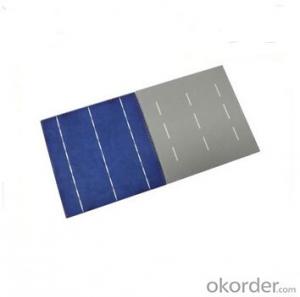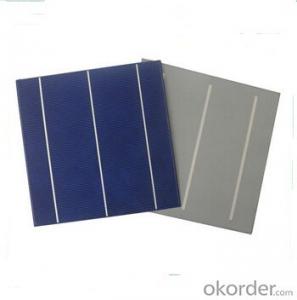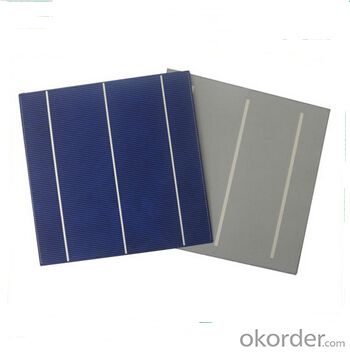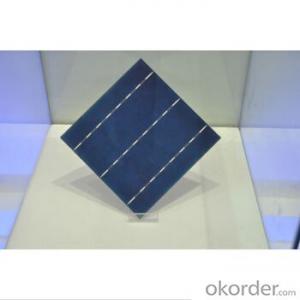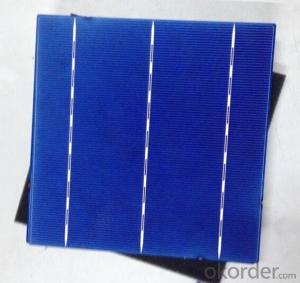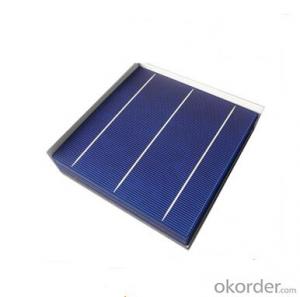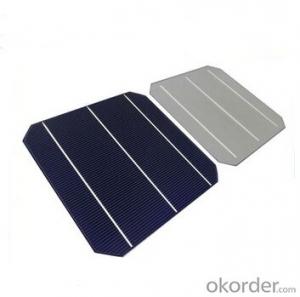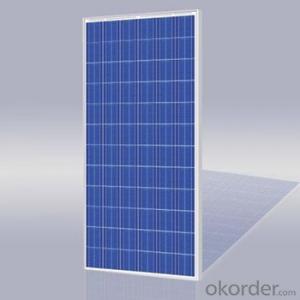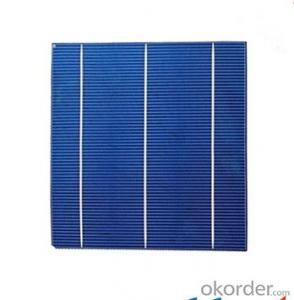High Quality Cigs Thin Film Solar Cells - Polycrystalline Solar Cells
- Loading Port:
- Shanghai
- Payment Terms:
- TT OR LC
- Min Order Qty:
- 1000 pc
- Supply Capability:
- 1000000 pc/month
OKorder Service Pledge
OKorder Financial Service
You Might Also Like
PolyCrystalline Silicon Solar Cell 3 Bus Bars Alkaline:
Solar cells is made by solar wafer, it has three categories of solar cell right now, monocrystalline polycrystalline and thin film,These cells are entirely based around the concept PN junction, which is the critical part of solar module, it is the part that can convert the light energy into electricity, the thickness is from 180um to 200um, with even busbars to conduct electricity, textured cell can decrease diffuse reflection; they are often electrically connected and encapsulated as a module. Photovoltaic modules often have a sheet of glass on the front (sun up) side, allowing light to pass while protecting semiconductor wafers from abrasion and impact due to wind-driven debris, rain, hail, etc. Solar cells are also usually connected in series in modules, creating an additive voltage. Connecting cells in parallel will yield a higher current;With high quality and stable quality. Our Cells can greatly improve the performance of Solar Modules.
PolyCrystalline Silicon Solar Cell 3 Bus Bars Alkaline Advantage:
• High efficiency and stable performance in photovoltaic conversion.
• Advanced diffusion technique ensuring the homogeneity of energy conversion efficiency of the cell.
• Advanced PECVD film forming, providing a dark blue silicon nitride anti-reflection film of homogenous color and attractive appearance.
• High quality metal paste for back surface and electrode, ensuring good conductivity, high pulling strength and ease of soldering.
• High precision patterning using screen printing, ensuring accurate busbar location for ease with automatic soldering a laser cutting.
Specifications:
Model | Efficiency | Power | Max Power Current | Min Power Current | Max Power Voltage | Short Circuit Current | Open Circuit Voltage |
Eff(%) | Ppm(W) | Ipm(A) | Ipm(A) | Vpm(V) | Isc(A) | Voc(V) | |
C-156P | 17.80-17.99 | 3.89 | 7.50 | 7.38 | 0.527 | 8.04 | 0.630 |
C-156P | 17.60-17.79 | 3.84 | 7.45 | 7.32 | 0.525 | 7.94 | 0.628 |
C-156P | 17.40-17.59 | 3.80 | 7.40 | 7.25 | 0.523 | 7.90 | 0.629 |
C-156P | 17.20-17.39 | 3.76 | 7.35 | 7.17 | 0.518 | 7.86 | 0.628 |
C-156P | 17.00-17.19 | 3.71 | 7.3 | 7.10 | 0.516 | 7.80 | 0.625 |
C-156P | 16.80-16.99 | 3.67 | 7.25 | 7.05 | 0.514 | 7.75 | 0.623 |
C-156P | 16.60-16.79 | 3.63 | 7.20 | 6.98 | 0.512 | 7.70 | 0.620 |
C-156P | 16.40-16.59 | 3.58 | 7.15 | 6.90 | 0.510 | 7.64 | 0.618 |
C-156P | 16.20-16.39 | 3.54 | 7.1 | 6.72 | 0.508 | 7.57 | 0.616 |
C-156P | 16.00-16.29 | 3.49 | 7.05 | 6.56 | 0.506 | 7.35 | 0.614 |
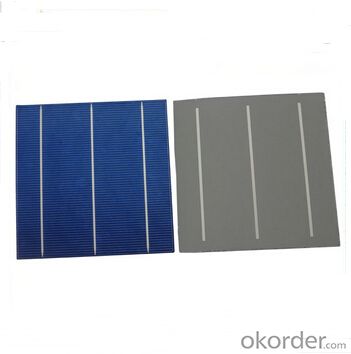
Packaging & Delivery of Polycrystalline Solar Cells
Carton Box Package and Deliver by air. It should be noticed that it should be avoid of water, sunshine and moist.
FAQ
We have organized several common questions for our clients,may help you sincerely:
①What price for each watt?
It depends on the efficiency of the solar cell, quantity, delivery date and payment terms.
②How long can we receive the product after purchase?
In the purchase of product within three working days, We will arrange the factory delivery as soon as possible. The pecific time of receiving is related to the state and position of customers.Commonly 7 to 10 working days can be served.
③Can you provide the peripheral products of the solar panels, such as the battery, controller, and inverter? If so, can you tell me how do they match each other?
Yes, we can, we have two companies for solar region, one is CNBM International, the other is CNBM engineering Co.
We can provide you not only the solar module but also the off grid solar system, we can also provide you service with on grid plant.
④What is your warranty of solar cell?
Our product can promise lower than 0.3% open box crack, we support claim after opening the box if it has crackm color difference or sth, the buyer should give pictures immediately, we can not accept the claim after the solar cell has assembled to solar panel.
• Timeliness of delivery
• ⑤How do you pack your products?
We have rich experience on how to pack the solar cell to make sure the safety on shipment, we could use wooden box or pallet as buyer's preference.
⑥ Can you do OEM for us?
Yes, we can.
- Q: What is the impact of solar cells on reducing noise pollution from power generation?
- Solar cells have a minimal impact on reducing noise pollution from power generation since they operate silently, unlike traditional power plants that emit noise during operation.
- Q: Can solar cells be used in aircraft applications?
- Yes, solar cells can be used in aircraft applications. They are commonly used in solar-powered aircraft to convert sunlight into electrical energy, which can then be used to power the aircraft's systems and/or charge its batteries. Solar cells can help reduce the reliance on fossil fuels, increase flight time, and contribute to more sustainable aviation.
- Q: What is the role of silicon in solar cells?
- The role of silicon in solar cells is to act as a semiconductor material that can absorb sunlight and convert it into electricity through the photovoltaic effect. Silicon is the most commonly used material in solar cell manufacturing due to its abundance, stability, and ability to efficiently convert sunlight into electricity. It forms the basis of the p-n junction, which allows for the separation and movement of electrons and holes, generating an electric current.
- Q: What are the disadvantages of using solar cells?
- One disadvantage of using solar cells is their high initial cost. The installation and setup of solar panels can be expensive, making it less accessible for some individuals or households. Additionally, solar cells are dependent on sunlight, so their efficiency can be affected by weather conditions, such as cloudy days or limited sunlight during winter months. Moreover, the production of solar cells involves the use of certain materials that can have environmental impacts, such as the extraction of rare minerals. However, advancements in technology and decreasing costs are gradually reducing these disadvantages and making solar energy a more viable option for sustainable energy production.
- Q: What is the average lifespan of a solar cell in space?
- The average lifespan of a solar cell in space can vary depending on various factors such as the quality of the materials used, the level of radiation exposure, and the overall design of the solar cell. However, on average, solar cells in space can last anywhere between 10 to 25 years.
- Q: Can solar cells be used on vehicles other than cars?
- Yes, solar cells can be used on vehicles other than cars. Solar cells can be integrated into various types of vehicles including buses, motorcycles, bicycles, boats, and even spacecraft. The energy generated by solar cells can be used to power the vehicle's electrical systems, reduce reliance on fossil fuels, and contribute to a more sustainable transportation infrastructure.
- Q: What is the impact of solar cells on reducing air pollution from power generation?
- Solar cells have a significant impact on reducing air pollution from power generation. By harnessing energy from the sun, solar cells produce electricity without emitting harmful pollutants such as carbon dioxide, sulfur dioxide, or nitrogen oxides. This clean and sustainable energy source helps to mitigate the negative effects of traditional fossil fuel-based power generation on air quality, thus contributing to a healthier environment and reducing the overall carbon footprint.
- Q: What factors affect the output of a solar cell?
- The factors that affect the output of a solar cell include the amount of sunlight it receives, the efficiency of the cell itself, the temperature, and any shading or obstructions that may block the sunlight.
- Q: Can solar cells be used for powering drones?
- Yes, solar cells can be used for powering drones. Solar-powered drones utilize photovoltaic cells to convert sunlight into electricity, which can then be used to power the drone's motor and other systems. This renewable energy source allows for longer flight times and reduced reliance on traditional fuel sources.
- Q: Can solar cells be used to power homes?
- Yes, solar cells can be used to power homes. Solar panels, made up of multiple solar cells, convert sunlight into electricity that can be used to power household appliances and lighting. This renewable energy source can provide a sustainable and cost-effective solution for residential power needs.
Send your message to us
High Quality Cigs Thin Film Solar Cells - Polycrystalline Solar Cells
- Loading Port:
- Shanghai
- Payment Terms:
- TT OR LC
- Min Order Qty:
- 1000 pc
- Supply Capability:
- 1000000 pc/month
OKorder Service Pledge
OKorder Financial Service
Similar products
Hot products
Hot Searches
Related keywords
